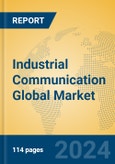Industrial Communication encompasses hardware, software, and services that enable seamless data exchange in industrial environments, supporting applications in automotive, aerospace, food & beverages, electronics, pharmaceuticals, oil & gas, and manufacturing. This market excels in bridging operational technologies with IT systems, driven by Industry 4.0, automation, and real-time monitoring needs, with trends shifting toward secure, high-speed, and interoperable solutions.
This product will be delivered within 1-3 business days.
Market Size and Growth Forecast
The global Industrial Communication market is estimated at USD 22 billion to USD 25 billion in 2025, with a projected CAGR of 7% to 9% from 2025 to 2030, reaching USD 33 billion to USD 40 billion by 2030, reflecting industrial digitalization.Regional Analysis
- North America: Growing at 6-8%, the U.S. leads with manufacturing automation, trending toward secure systems.
- Europe: With a 5-7% growth rate, Germany excels in industrial upgrades, focusing on interoperability.
- Asia Pacific: Exhibiting an 8-10% growth rate, China dominates with scale, trending toward cost-effective solutions.
- Middle East and Africa (MEA): Growing at 4-6%, the UAE advances with oil & gas, emphasizing reliability.
- South America: With a 5-7% growth rate, Brazil leads with industrial growth, focusing on affordability.
Application Analysis
- Automotive & Transportation: Projected at 8-10%, it thrives on automation, trending toward real-time systems.
- Aerospace & Defense: Expected at 6-8%, it serves secure needs, focusing on rugged designs.
- Food & Beverages: Growing at 5-7%, it enhances efficiency, with sanitary solutions rising.
- Electrical & Electronics: Projected at 7-9%, it supports IoT, trending toward high-speed connectivity.
- Pharmaceuticals & Medical Devices: Expected at 6-8%, it ensures compliance, focusing on precision.
- Oil & Gas: Growing at 5-7%, it serves remote operations, with durable systems trending.
- Industrial Manufacturing: Projected at 7-9%, it drives automation, targeting scalable solutions.
- Others: Expected at 4-6%, niche uses expand, driven by custom needs.
Product Type Analysis
- Software: Projected at 8-10%, it excels in analytics, trending toward cloud integration.
- Hardware: Expected at 6-8%, it provides infrastructure, with compact designs rising.
- Services: Growing at 7-9%, it supports deployment, focusing on tailored solutions.
Key Market Players
- ABB: A global leader in industrial automation solutions.
- Advantech: A versatile innovator in connectivity systems.
- Cisco Systems: A robust titan in secure networking.
- IBM: A strategic pioneer in industrial software.
- HPE: A reliable provider of scalable solutions.
- Emerson Electric: A practical leader in process control.
- General Electric: A dynamic innovator in industrial tech.
- National Instruments: A precision creator of testing systems.
- Rockwell Automation: A spirited leader in automation solutions.
- Schneider Electric: A vibrant provider of smart systems.
- Siemens: A steadfast titan in industrial communication.
- Texas Instruments: A resourceful innovator in hardware.
- Belden: A reliable leader in industrial cables.
- Honeywell: A creative force in control solutions.
- Arista Networks: A dynamic innovator in high-speed designs.
- Broadcom: A precision leader in semiconductor solutions.
- Alcatel-Lucent Enterprise: A vibrant provider of enterprise systems.
- HMS Networks: A practical innovator in connectivity.
- Moxa: A spirited creator of rugged solutions.
- Juniper Networks: A strategic leader in secure networks.
- Huawei: A versatile giant in global connectivity.
- ZTE: A resourceful provider of scalable systems.
Porter’s Five Forces Analysis
- Threat of New Entrants: Medium, with technical barriers, though niche players emerge.
- Threat of Substitutes: Medium, as wireless competes, yet wired reliability endures.
- Bargaining Power of Buyers: Medium to high, with industries negotiating, balanced by expertise.
- Bargaining Power of Suppliers: Medium, as component reliance grants leverage, offset by scale.
- Competitive Rivalry: High, with innovation and pricing driving competition.
- Impact of Tariff Conflicts on Supply Chain Localization
Market Opportunities and Challenges
Opportunities
- Industry 4 adoption: Automation drives demand, enhancing communication scope.
- IoT growth: Device connectivity fuels need, targeting real-time solutions.
- Smart manufacturing: Efficiency gains boost use, supporting scalability.
- Emerging market potential: Industrial growth in Asia Pacific offers avenues, fueled by scale.
- Security focus: Rising cyber needs drive adoption, appealing to regulated sectors.
Challenges
- High costs: Expensive systems limit affordability, challenging scale.
- Interoperability issues: Diverse standards slow integration, complicating deployments.
- Cybersecurity risks: Threats demand robust protection, raising costs.
- Supply chain volatility: Component shortages disrupt production, testing operations.
- Competitive pressure: Intense rivalry squeezes margins, needing differentiation.
This product will be delivered within 1-3 business days.
Table of Contents
Chapter 1 Executive SummaryChapter 2 Abbreviation and Acronyms
Chapter 3 Preface
Chapter 4 Market Landscape
Chapter 5 Market Trend Analysis
Chapter 6 Industry Chain Analysis
Chapter 7 Latest Market Dynamics
Chapter 8 Historical and Forecast Industrial Communication Market in North America (2020-2030)
Chapter 9 Historical and Forecast Industrial Communication Market in South America (2020-2030)
Chapter 10 Historical and Forecast Industrial Communication Market in Asia & Pacific (2020-2030)
Chapter 11 Historical and Forecast Industrial Communication Market in Europe (2020-2030)
Chapter 12 Historical and Forecast Industrial Communication Market in MEA (2020-2030)
Chapter 13 Summary For Global Industrial Communication Market (2020-2025)
Chapter 14 Global Industrial Communication Market Forecast (2025-2030)
Chapter 15 Analysis of Global Key Vendors
List of Tables and Figures
Companies Mentioned
- ABB
- Advantech
- Cisco Systems
- IBM
- HPE
- Emerson Electric
- General Electric
- National Instruments
- Rockwell Automation
- Schneider Electric
- Siemens
- Texas Instruments
- Belden
- Honeywell
- Arista Networks
- Broadcom
- Alcatel-Lucent Enterprise
- HMS Networks
- Moxa
- Juniper Networks
- Huawei
- ZTE








